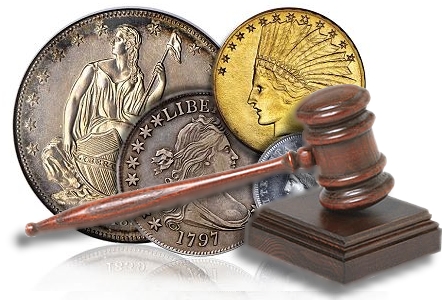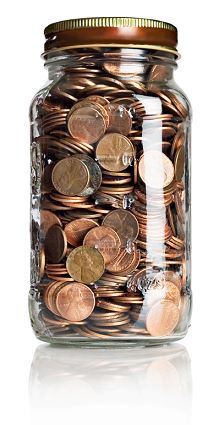Posted by Jeff Garrett on the Numismatic Guaranty Corporation Weekly Market Report …..
Consigning coins to auction is not always a simple matter. There are many factors to consider.
Heritage Auctions recently sold a significant portion of the incomparable Eric Newman collection. The NGC graded coins realized over $23,000,000. His original cost for this group of coins is estimated at around $7,500-WOW!! As many of you know, Eric is over 100 years old and has only recently decided to sell selections from his rare coins and paper money collection. Most of the proceeds have been designated for various charities. While Eric Newman’s numismatic achievements are incredible and his collection is equally astounding, his acquisition and disposal plan is not one that most will follow. Not very many collectors can assemble a group of coins that will be so eagerly snapped up when offered for sale.
Selling your collection of rare coins at auction is an easy decision if you have a collection that has been formed over decades. The market will handsomely reward anyone who consigns such material. Unfortunately, not very many collectors are in this position. Most have collections that they have assembled in the last 5-10 years, and sometimes need to sell coins for one reason or another. Consigning coins to auction is not always a simple matter. There are many factors to consider. This same advice can apply to dealers consigning material for sale.
 The most important thing to remember is not everything does well at auction. The biggest mistake many collectors and dealers make is to consign material to auction that they have been unable to sell through other channels. I have seen lots of fellow coin dealers purchase nice collections and then start selling the best coins at the first opportunity. They are quickly left with the off quality or unpopular material. These coins will sit around for months and the frustrated dealer will consign them to auction, hoping for the best. They are usually deeply disappointed. If the coins are sold without reserve they might face steep losses. If the coins do not meet reserves, they will still have the coins and have to pay buy back charges. Neither result is very pleasant.
The most important thing to remember is not everything does well at auction. The biggest mistake many collectors and dealers make is to consign material to auction that they have been unable to sell through other channels. I have seen lots of fellow coin dealers purchase nice collections and then start selling the best coins at the first opportunity. They are quickly left with the off quality or unpopular material. These coins will sit around for months and the frustrated dealer will consign them to auction, hoping for the best. They are usually deeply disappointed. If the coins are sold without reserve they might face steep losses. If the coins do not meet reserves, they will still have the coins and have to pay buy back charges. Neither result is very pleasant.
To avoid the above scenario, you should save the best coins for auction and sell the lower quality coins at a discount as soon as possible. This advice might sound simple, but it is vital to have the greatest success when consigning coins. For the best results you should only consider selling coins at auction that a collector would be eager to purchase. You want collectors to be bidding competitively for your coins and not dealers who are buying coins and have factored out the commissions. For instance, there is no need to sell generic gold coins in an auction setting. The auction commissions would be much higher than selling directly to dealers who specialize in this field. On the other hand, if you owned a 1932 Double Eagle, collectors would be happy to battle each other in an auction format to purchase the coin.
I am often asked if a collection of coins should be broken up or sold intact as one unit. In most cases it is best to sell coins individually. The explanation for this is rather simple—most people cannot afford to purchase a complete set of anything. The price point would be too high and many already have some of the coins if they are interested in the series. There are exceptions, such as an early Proof set from 1858-1915. Many collectors or dealers will actually pay a premium to acquire a matched, original set.
One of the biggest questions facing consignors these days is whether or not to place reserves. The auction houses make more money if all of your coins sell, so their advice on this issue can sometimes be self serving. Consigning a valuable collection to auction without reserves can be a scary proposition. There are several issues, however, that make this option one to consider. The best overall commission rates are usually given for coins consigned without reserve. More importantly, bidders seem to be more excited when coins are offered without reserve. Bidders love the security of an under bidder and will sometimes end up stretching if they feel a coin is fresh and being sold unreserved.
There are certain cases, however, where setting a reserve can be very important. This usually applies to thinly traded markets or a specialty field. There may be very few buyers for a coin or piece of currency. A prime example of this would be Kentucky National Bank Notes, which I collect. If someone consigns a note that is needed for my collection, I will bid aggressively (maybe irrationally) to purchase the lot. The problem is that I might be the only bidder interested. In this case if the lot were sold unreserved, I might buy the note for much less than I was willing to pay. It would be wise to set a reasonable reserve. Setting reserves can be very tricky business and seeking advice from an expert is highly recommended.
 Another somewhat subtle decision is which kind of sale to consign your coins to. These days, major convention auctions will have total sales in the tens of millions. For smaller consignors, your collection could easily get lost in the crowd or be overwhelmed by higher quality coins. The commission rates can also be higher for major sales and should be taken into consideration. If you have a serious collection, then you would want your coins featured in this type of auction. Lots of coins are sold on the Internet, but there is still plenty of excitement in a well attended floor auction. Bottom line: look for a sale that fits your collection. Also, do not be afraid to negotiate for the best possible commission rate.
Another somewhat subtle decision is which kind of sale to consign your coins to. These days, major convention auctions will have total sales in the tens of millions. For smaller consignors, your collection could easily get lost in the crowd or be overwhelmed by higher quality coins. The commission rates can also be higher for major sales and should be taken into consideration. If you have a serious collection, then you would want your coins featured in this type of auction. Lots of coins are sold on the Internet, but there is still plenty of excitement in a well attended floor auction. Bottom line: look for a sale that fits your collection. Also, do not be afraid to negotiate for the best possible commission rate.
Many of you have invested years of your time and large sums of money into your collection. When it comes time to sell, some careful planning will pay huge dividends. As always, it is highly recommended to seek advice from an expert when making big decisions about your collection. This may be the dealer who helped assemble your collection or someone who is an expert in the specialty you have chosen to collect. Finally, remember that the auction business is very competitive, and you should shop around for the best overall consignment strategy that meets your needs.
In my next article I will discuss “Selling by Private Treaty”.
Questions about the rare coin market? Send them to [email protected].
About Jeff Garrett
 Jeff Garrett, founder of Mid-American Rare Coin Galleries, is considered one of the nation’s top experts in U.S. coinage — and knowledge lies at the foundation of Jeff’s numismatic career. With more than 35 years of experience, he is one of the top experts in numismatics. The “experts’ expert,” Jeff has personally bought and sold nearly every U.S. coin ever issued. Not a day goes by that someone doesn’t call on Jeff Garrett for numismatic advice. This includes many of the nation’s largest coin dealers, publishers, museums and institutions.
Jeff Garrett, founder of Mid-American Rare Coin Galleries, is considered one of the nation’s top experts in U.S. coinage — and knowledge lies at the foundation of Jeff’s numismatic career. With more than 35 years of experience, he is one of the top experts in numismatics. The “experts’ expert,” Jeff has personally bought and sold nearly every U.S. coin ever issued. Not a day goes by that someone doesn’t call on Jeff Garrett for numismatic advice. This includes many of the nation’s largest coin dealers, publishers, museums and institutions.
In addition to owning and operating Mid-American Rare Coin Galleries, Jeff Garrett is a major shareholder in Sarasota Rare Coin Galleries. His combined annual sales in rare coins and precious metals — between Mid-American in Kentucky and Sarasota Rare Coin Galleries in Florida — total more than $25 million.
Jeff Garrett has authored many of today’s most popular numismatic books, including Encyclopedia of U.S. Gold Coins 1795–1933: Circulating, Proof, Commemorative, and Pattern Issues; 100 Greatest U.S. Coins; and United States Coinage: A Study By Type. He is also the price editor for The Official Redbook: A Guide Book of United States Coins.
Jeff was also one of the original coin graders for the Professional Coin Grading Service (PCGS). He is today considered one of the country’s best coin graders and was the winner of the 2005 PCGS World Series of Grading. Today, he serves as a consultant to Numismatic Guaranty Corporation (NGC), the world’s largest coin grading company.
Jeff plays an important role at the Smithsonian Institution’s National Numismatic Department and serves as consultant to the museum on funding, exhibits, conservation and research. Thanks to the efforts of Jeff and many others, rare U.S. coins are once again on exhibit at the Smithsonian Institution’s Museum of American History. We urge everyone who visits Washington, D.C., to view this fabulous display.
Jeff has been a member of the prestigious Professional Numismatic Guild (PNG) since 1982 and has recently served as president of the organization. In 2009 and 2011, Jeff ran successfully for a seat on the Board of Governors for the American Numismatic Association (ANA), the leading numismatic club in the world. He plans to run for ANA vice president in 2013.




